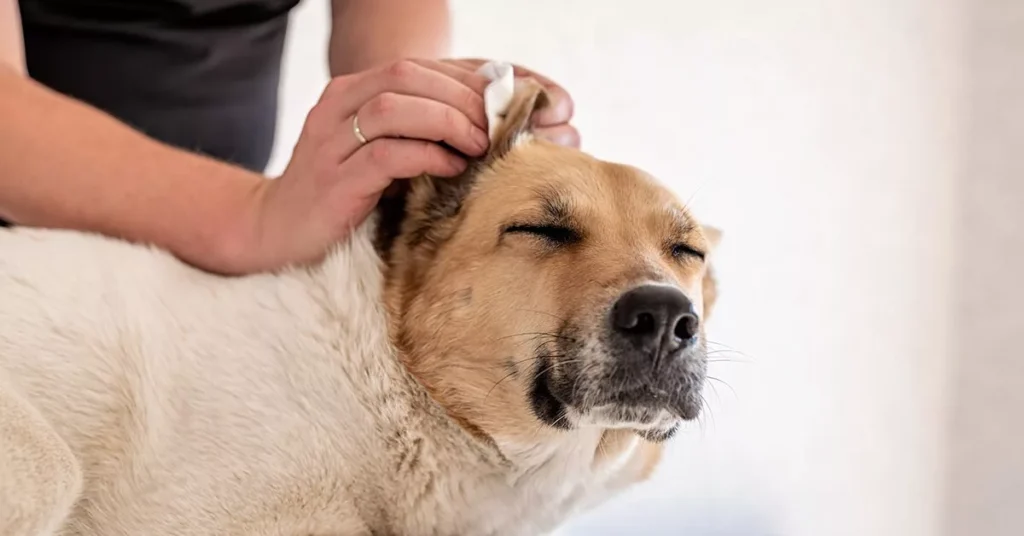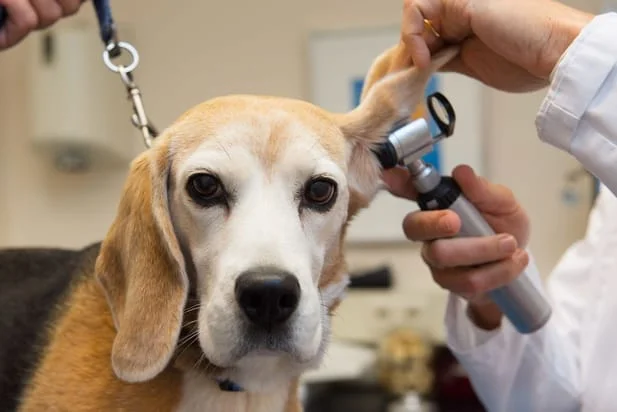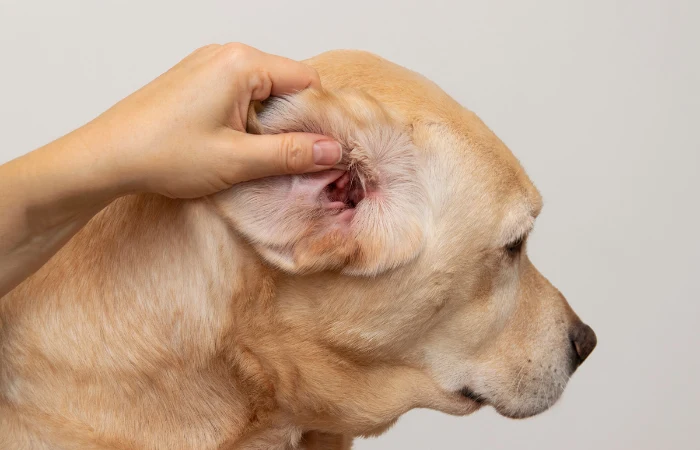Contents
Introduction:
Ensuring the well being of our canine companions encompasses a multifaceted approach, and one often overlooked aspect is the proper care of their ears. The significance of dog ear cleaning extends beyond mere aesthetics, delving into the realm of preventive healthcare and the fostering of a harmonious pet owner relationship. In this comprehensive guide, we will explore not only the imperative nature of this often neglected task but also the intricacies involved in understanding the anatomy of a dog’s ear and the step by step process of cleaning it effectively.
The aural health of our dogs is pivotal, considering their heightened sense of hearing and the potential susceptibility to various ear related issues. From the external pinna to the intricate ear canal and delicate ear drum, each component plays a crucial role in auditory function and overall canine well being. By comprehending the nuances of these anatomical structures, pet owners can proactively engage in preventative measures, averting potential complications and ensuring their furry friends enjoy a life free from discomfort.
To embark on this journey of responsible dog ear care, it is essential to first equip ourselves with the right tools and knowledge. Gathering supplies, understanding the temperament of our dogs, and creating a suitable environment are integral preludes to a successful ear cleaning session. As we delve into the step by step guide, we’ll not only navigate the practicalities of the cleaning process but also unravel the psychology behind it, emphasizing the significance of positive reinforcement and trust building between the pet and its caregiver.
Furthermore, this guide will shed light on common mistakes to avoid, demystifying misconceptions surrounding ear cleaning practices. We will also delve into the signs that should prompt immediate veterinary attention, recognizing that proactive healthcare is pivotal in addressing underlying issues before they escalate.
Understanding the Anatomy of a Dog’s Ear:
Within the intricate architecture of a dog’s ear lies a fascinating symphony of structures that collectively contribute to their acute auditory abilities. To embark on the journey of responsible ear care, it is paramount to unravel the intricacies of this anatomy, appreciating the role each component plays in maintaining optimal ear health.
The external ear, known as the pinna, serves as the visible gateway to this auditory system. Beyond its aesthetic role, the pinna plays a crucial role in capturing soundwaves and funneling them towards the ear canal. Understanding the variations in pinna shapes across different breeds adds an additional layer of awareness, emphasizing that ear care practices may need to be tailored to individual characteristics.
Delving deeper, the ear canal, a seemingly unassuming passage, reveals itself as a vital conduit connecting the pinna to the eardrum. The ear canal’s shape and length can vary among breeds, influencing the propensity for ear issues. A nuanced understanding of this structure is essential during the cleaning process to ensure a thorough yet gentle approach.
At the core of this auditory system lies the ear drum, a delicate membrane that translates sound vibrations into neural signals. Recognizing the fragility of the ear drum underscores the importance of a meticulous and cautious cleaning regimen. A rupture or damage to this membrane can lead to severe consequences, making it imperative to approach ear cleaning with a blend of diligence and sensitivity.
By comprehending the intricacies of a dog’s ear anatomy, pet owners can transcend beyond a routine task and engage in a mindful practice that acknowledges the uniqueness of their canine companion. This section aims to empower caregivers with the knowledge needed to navigate the different components of the ear, fostering an environment of informed and proactive ear care. As we progress, we will transition from theoretical insights to practical applications, seamlessly integrating understanding with action for the holistic benefit of our furry friends.
Gathering Supplies:
In the pursuit of responsible dog ear care, assembling the right tools is akin to preparing for a meticulous yet nurturing task. Each item in your arsenal contributes to the overall effectiveness of the ear cleaning process, ensuring a positive experience for both you and your canine companion. Here, we delve into the essential supplies needed to embark on this journey of aural hygiene.
Cotton Balls or Pads:
These soft and absorbent materials serve as the primary tools for cleaning the external ear and ear canal. Their gentle texture ensures thorough cleaning without causing abrasions or discomfort. Opting for high quality, unbleached cotton balls minimizes the risk of irritation.
Dog Ear Cleaner Solution:
Choosing the right ear cleaner is pivotal to the success of the cleaning process. Specialized dog ear cleaner solutions are formulated to break down wax and debris, promoting a healthy ear environment. It is crucial to consult with your veterinarian to select a product suitable for your dog’s specific needs.
Towels or Tissues:
Having towels or tissues on hand is essential for drying your dog’s ears after the cleaning process. Gently patting the ears dry helps prevent moisture related issues and ensures your dog remains comfortable post cleaning.
Dog Treats (for positive reinforcement):
Incorporating positive reinforcement into the ear cleaning routine establishes a connection between the activity and a positive experience for your dog. High value treats serve as rewards, making the process more enjoyable for your furry friend and strengthening the bond between pet and owner.
Assembling these supplies before initiating the ear cleaning process ensures a seamless and organized experience. Creating a designated space with all necessary items within arm’s reach fosters efficiency and minimizes stress for both you and your dog. In the subsequent sections, we will explore not only how to use these supplies effectively but also the importance of creating a conducive environment to instill a sense of calm and trust in your canine companion.
Preparing Your Dog:
Before delving into the practicalities of dog ear cleaning, establishing a conducive environment and understanding your dog’s temperament are foundational steps for a successful and stress free experience. This section emphasizes the importance of thoughtful preparation, setting the stage for a positive interaction between you and your furry companion.

Choose a Quiet and Comfortable Area:
Selecting the right location for the ear cleaning session is crucial. Opt for a quiet and comfortable space where your dog feels secure. Minimize distractions to help maintain your dog’s focus and reduce anxiety during the process.
Gather Treats and Calm Your Dog:
Prior to initiating the ear cleaning routine, spend a few moments calming your dog. Offer gentle strokes and soothing words to reassure them. Having treats readily available not only serves as positive reinforcement but also creates a positive association with the cleaning process.
Brush Your Dog’s Fur (if necessary):
Long haired breeds may benefit from a gentle brushing before ear cleaning. This helps prevent loose fur from falling into the ear canal during the process. Additionally, brushing contributes to a sense of routine and familiarity for your dog.
Establishing a calm and predictable routine is essential in creating a positive experience for your dog. Dogs are highly perceptive to their surroundings and the energy of their owners, so maintaining a composed demeanor throughout the preparation phase fosters a sense of trust. As we transition to the step by step guide, these preparatory steps will lay the foundation for a harmonious ear cleaning experience, promoting a bond of understanding and cooperation between you and your beloved pet.
Step by Step Guide to Cleaning Dog Ears:
Navigating the process of cleaning your dog’s ears requires a systematic and gentle approach. This step by step guide is designed to demystify the ear cleaning procedure, breaking it down into manageable stages for both you and your furry companion. By adhering to these guidelines, you’ll not only ensure thorough ear hygiene but also cultivate a positive and cooperative interaction with your dog.

Inspecting the Ears:
Begin by visually inspecting your dog’s ears. Look for signs of redness, swelling, or discharge. Take note of any unusual odors emanating from the ears. This initial assessment provides valuable information about the ear’s current condition.
Applying Dog Ear Cleaner:
Select a veterinarian approved dog ear cleaner solution. Hold your dog’s head gently but firmly, tilting it slightly to expose the ear canal. With precision, pour the recommended amount of ear cleaner onto a cotton ball, ensuring saturation without excess dripping.
Cleaning the Outer Ear:
Start by gently wiping the external ear (pinna) with the soaked cotton ball. Pay attention to folds and crevices where dirt or debris may accumulate. Be cautious not to insert anything into the ear canal at this stage.
Cleaning the Ear Canal:
To clean the ear canal, lift the ear flap and expose the entrance. Gently insert the cotton ball into the ear canal, rotating it to remove wax and debris. Use additional cotton balls as needed, ensuring a thorough yet gentle cleaning process.
Drying the Ears:
Allow your dog to shake its head. This natural behavior helps expel excess moisture and cleaner from the ears. Use a towel or tissue to gently pat the ears dry, ensuring they are free from any residual moisture.
This step by step approach combines precision with sensitivity, acknowledging the unique characteristics of each dog. The aim is not only to maintain optimal ear health but also to foster trust and cooperation between you and your pet. As we progress through the subsequent sections, additional insights into common mistakes to avoid and signs requiring veterinary attention will further enhance your proficiency in dog ear care.
Tips for Safe and Effective Dog Ear Cleaning:
Ensuring the safety and efficacy of the dog ear cleaning process involves a combination of knowledge, patience, and a keen understanding of your dog’s needs. This section compiles essential tips to guide you through the cleaning routine, enhancing both the well being of your canine companion and the success of the ear cleaning endeavor.
Use Only Dog Safe Products:
Select ear cleaners specifically formulated for dogs. Avoid using human ear cleaning solutions, as they may contain ingredients that can be harmful to canine ears. Consult with your veterinarian to choose a product that suits your dog’s individual needs.
Be Gentle and Patient:
Approach the ear cleaning process with a gentle touch. Dogs may initially resist or feel uncomfortable, so patience is key. Avoid rushing through the procedure, allowing your dog to acclimate to each step at their own pace.
Stop If Your Dog Shows Discomfort:
Pay close attention to your dog’s body language. If your dog shows signs of discomfort, such as pulling away, whimpering, or displaying stress signals, pause the cleaning process. Pushing through when your dog is uncomfortable can create negative associations with ear cleaning.
Regular Cleaning Schedule:
Establishing a regular ear cleaning schedule is crucial for preventative care. The frequency may vary based on your dog’s breed, ear shape, and susceptibility to ear issues. Consult with your veterinarian to determine an appropriate schedule for your dog’s specific needs.
These tips not only contribute to the effectiveness of the ear cleaning process but also contribute to a positive experience for both you and your dog. By prioritizing safety, gentleness, and consistency, you lay the foundation for a routine that promotes optimal ear health and strengthens the bond between you and your furry companion. As we delve into common mistakes to avoid in the subsequent section, these tips will serve as a cornerstone for successful dog ear care.
Common Mistakes to Avoid:
While the intention behind cleaning your dog’s ears is to promote their well being, certain common mistakes can inadvertently lead to discomfort or, in some cases, exacerbate existing issues. Recognizing and avoiding these pitfalls is essential for maintaining a positive ear care experience for your canine companion. Let’s explore these common mistakes to ensure a more effective and stress free ear cleaning routine:
Using Q Tips or Sharp Objects:
Resist the temptation to use Q tips or any sharp objects to clean the ear canal. This can push debris further into the ear, potentially causing damage to the delicate structures within. Stick to the use of cotton balls or pads for a safer and more controlled cleaning process.
Skipping Ear Inspections:
Neglecting regular ear inspections is a common oversight. Early detection of redness, swelling, or discharge can help address potential issues before they escalate. Regular inspections also allow you to stay informed about your dog’s ear health and adjust the cleaning frequency accordingly.
Overcleaning the Ears:
While regular cleaning is essential, overcleaning can strip the ear of its natural protective oils and disrupt the balance of the ear environment. Follow a veterinarian recommended cleaning schedule based on your dog’s specific needs to avoid overcleaning and potential irritation.
By steering clear of these common pitfalls, you not only safeguard your dog from unnecessary discomfort but also contribute to the overall success of your ear cleaning efforts. Maintaining a mindful and informed approach to dog ear care ensures that each cleaning session is a positive experience, reinforcing the trust and cooperation between you and your furry friend. As we move forward, the focus will shift to recognizing signs that warrant veterinary attention, rounding out the comprehensive guide to dog ear care.
Signs of Ear Problems Requiring Vet Attention:

Vigilance in monitoring your dog’s ear health goes beyond routine cleaning; it involves recognizing potential signs of issues that necessitate professional veterinary attention. This section outlines crucial indicators that should prompt you to seek the expertise of a veterinarian, ensuring timely intervention and the well being of your canine companion.
Persistent Discharge:
If you observe persistent discharge from your dog’s ears, particularly if it is discolored, has an unpleasant odor, or increases over time, this may indicate an infection or other underlying issue. Seeking veterinary guidance is essential to determine the cause and implement appropriate treatment.
Foul Odor:
An unusual and persistently foul odor emanating from your dog’s ears could signal an infection or the presence of foreign objects. A veterinarian can conduct a thorough examination to identify the source of the odor and recommend the necessary course of action.
Excessive Scratching or Head Shaking:
Dogs naturally scratch or shake their heads occasionally, but an increase in these behaviors may indicate discomfort or irritation. Persistent scratching, head shaking, or rubbing the ears against surfaces could signal an ear problem that requires professional assessment.
Redness or Swelling:
Redness or swelling in or around the ear area may be indicative of inflammation or infection. These visible signs should not be ignored, as they often signify an underlying issue that requires prompt veterinary attention to prevent further complications.
Recognizing these signs early on allows for timely intervention, preventing potential discomfort and ensuring the overall health of your dog. If you observe any of these indicators, it is advisable to consult with your veterinarian promptly. This proactive approach to addressing ear problems underscores the importance of a collaborative relationship between pet owners and veterinary professionals, promoting the best possible outcomes for your beloved canine companion.
Conclusion:
As we conclude this comprehensive guide to dog ear cleaning, we reflect on the integral role this often overlooked aspect of pet care plays in promoting the overall health and well being of our canine companions. By understanding the importance of regular ear maintenance, appreciating the intricacies of a dog’s ear anatomy, and following a systematic and gentle cleaning process, pet owners can actively contribute to their furry friend’s comfort and happiness.
Regular ear cleaning is not merely a hygiene task; it is a proactive measure that fosters a harmonious bond between pet and owner. Beyond the practicalities of the cleaning process, this guide has emphasized the significance of creating a positive association with ear care through treats, patience, and a calm environment. By approaching ear cleaning as a shared experience rather than a chore, you cultivate trust, making future cleaning sessions more manageable.
The inclusion of tips for safe and effective cleaning, awareness of common mistakes to avoid, and recognition of signs requiring veterinary attention further empower pet owners with the knowledge needed to navigate the complexities of dog ear care. This holistic approach aims not only to maintain optimal ear health but also to enhance the quality of life for our canine companions.
In essence, dog ear cleaning is a testament to the commitment and responsibility that come with pet ownership. As you embark on this journey of caring for your dog’s ears, may this guide serve as a valuable resource, equipping you with the tools and insights necessary to create a positive and enriching ear care routine. With each gentle cleaning session, you contribute not only to the physical well being of your dog but also to the enduring bond that defines the unique and cherished relationship between you and your loyal companion.
